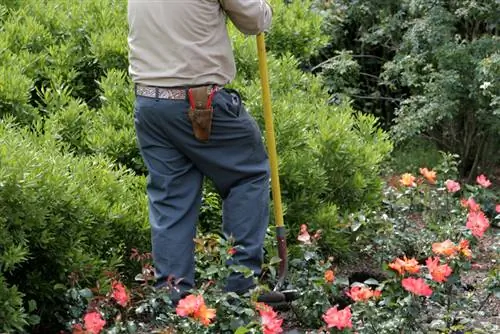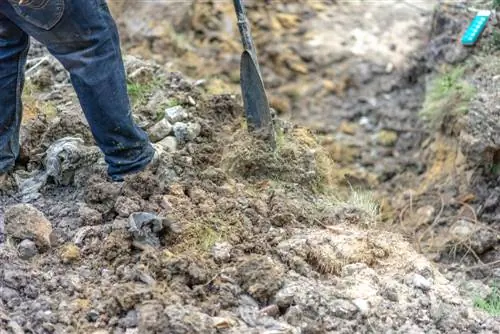- Author admin [email protected].
- Public 2023-12-16 16:46.
- Last modified 2025-01-23 11:20.
There are many reasons why a rose bush can no longer stay in its location and has to move - be it because the plant doesn't feel comfortable there or you have to move it for structural or design reasons. The younger the rose, the easier it is to dig up, but with older specimens you have to be more careful.

How to properly dig up and move roses?
To successfully dig up and transplant a rose, choose fall or spring as the ideal time. Shorten shoots and foliage, carefully lift the plant and pay attention to the roots. Then plant in the new location, water and hill up well with soil.
The right time to dig up and transplant roses
To minimize the shock of digging up and transplanting, it is best to undertake these measures in the fall or early spring. The temperatures should be above zero at this point and the ground should not be frozen. Removing it in autumn also has the advantage that the rose bush can establish itself in its new location by spring and sprout again and produce flowers. If you cannot wait until autumn (for example because you need to save an ailing rose), then make sure that the plant is not too dry.
Younger roses survive transplanting better than older ones
In general, it is easier to dig up and move younger roses up to four or five years old. The older a rose is, the larger and deeper its roots are - and the more difficult it is to get them out of the ground as undamaged as possible. However, you should try, because the more roots the plant retains, the better it will survive digging.
Pay attention to the taproots when digging out
When digging, proceed as follows:
- First prune the rose bush thoroughly.
- Short the long shoots back significantly - to just under 40 or 50 centimeters.
- If you also need to store or transport the unearthed rose for a long time,
- It's best to remove all the leaves.
- This reduces evaporation and ensures that the plant does not die of thirst.
- After pruning, dig up the rose.
- Prick deeply around the rose bush with a spade,
- for younger roses about one to two spade depths,
- for older ones, you should dig a trench.
- Now you can stick a digging fork under the rhizome
- and carefully lever out the rose.
Cut out bruised or otherwise injured roots carefully with a sharp knife.
Tip
After replanting, water the rose thoroughly and then hill it up well with soil. The transplanted rose also needs good winter protection.






